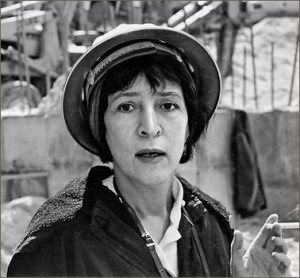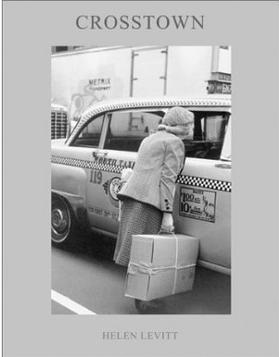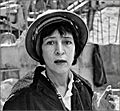Helen Levitt facts for kids
Quick facts for kids
Helen Levitt
|
|
|---|---|

1963
|
|
| Born | August 31, 1913 Brooklyn, New York, U.S.
|
| Died | March 29, 2009 (aged 95) New York City, U.S.
|
| Known for | Photography |
Helen Levitt (August 31, 1913 – March 29, 2009) was an American photographer and filmmaker. She was famous for her "street photography" in New York City. This means she took pictures of everyday life on the streets. One writer called her "the most celebrated and least known photographer of her time."
A special show of Helen Levitt's photos, called In the Street, was held in London from October 2021 to February 2022.
Contents
Early Life and Beginnings
Helen Levitt was born in Bensonhurst, Brooklyn, New York. Her family came from Russia. She went to New Utrecht High School but left school in 1931.
Becoming a Photographer
Helen started taking photos when she was 18 years old. In 1931, she learned how to develop pictures in a darkroom. She worked for a photographer in the Bronx. She also went to many classes about film and photography in Manhattan.
Around this time, she saw the work of a famous photographer named Henri Cartier-Bresson. She even met him. His photos really inspired her. She changed her style from taking commercial photos to taking more personal ones.
Capturing Street Life
In 1936, Helen bought a Leica Camera. This was a special camera that helped her take quick, natural photos. While teaching art to kids in 1937, she became interested in the chalk drawings children made on the streets of New York. She started taking pictures of these drawings and the children who made them. These photos were later published in a book called In The Street: chalk drawings and messages, New York City 1938–1948.
She continued to take street photos, especially in East Harlem and the Lower East Side of Manhattan. In the 1930s and 1940s, people spent more time outside because there was no air conditioning. This made street photography very interesting. Her photos were first shown in Fortune magazine in 1939. The Museum of Modern Art in New York also showed her work in its very first photography exhibit that same year. In 1941, she visited Mexico City and took many photos there. In 1943, she had her first solo photo show, called Helen Levitt: Photographs of Children.
Color Photography and Later Work
In 1959 and 1960, Helen received special grants to work on color photography. In 1965, she released her first big collection of photos, called A Way of Seeing. Sadly, many of her color photos from 1959-1960 were stolen from her apartment in 1970. The photos that were left, plus new ones she took, can be seen in her 2005 book Slide Show: The Color Photographs of Helen Levitt.
She had another solo show at the Museum of Modern Art in 1974, focusing on her color work. Helen Levitt lived in New York City and kept taking photos for almost 70 years. However, she noticed how much the city changed: "I go where there's a lot of activity. Children used to be outside. Now the streets are empty. People are indoors looking at television or something."
Work in Filmmaking
In the late 1940s, Helen Levitt also made documentary films. She worked with Janice Loeb and James Agee on two movies: In the Street (1948) and The Quiet One (1948). Helen Levitt and her co-workers were even nominated for an Academy Award for The Quiet One.
She worked in filmmaking for about 25 years. Her last film job was as an editor for a documentary called The End of an Old Song (1972). She also worked as a cinematographer (the person who films) on The Savage Eye (1960) and as an assistant director for The Balcony (1963).
Photography Style and Themes
Helen Levitt was best known for her photos of children playing in the streets. She often took pictures in areas like Harlem and the Lower East Side, where many different groups of people lived. Her photos often show children playing games.
Instead of showing sadness or problems, she chose to show the world from a child's point of view. She took pictures of their chalk art and their games. She carefully set up her camera to make the people in her photos look strong and important.
At the time, new laws in New York City were trying to limit how much working-class people could use public spaces. There were new rules about noise, and people tried to stop children from playing in the streets, saying it was unsafe. They wanted kids to play in new, safer areas, which were often built in richer neighborhoods. Helen Levitt's photos showed the lives of people who lived and played in these streets. Her work helped to give a voice to the people she photographed.
Personal Life and Death
In the 1990s, Helen had to stop making her own photo prints because of a health problem called sciatica, which made it hard to stand and carry her camera. She switched to a smaller, automatic camera. She also had a lifelong inner-ear problem called Meniere's syndrome, which made her feel wobbly.
Helen Levitt lived a very private and quiet life. She rarely gave interviews. She never married and lived alone with her cat, Blinky. Helen Levitt passed away peacefully in her sleep on March 29, 2009, when she was 95 years old.
Exhibitions
Solo Exhibitions
- Helen Levitt: Photographs of Children, Museum of Modern Art, New York, 1943.
- Projects: Helen Levitt in Color, Museum of Modern Art, New York, 1974.
- Street Portrait: The Photographs of Helen Levitt, Museum of Fine Arts, Boston, 1983.
- Moderna Museet, Stockholm, 1985. (A show looking back at her whole career).
- The Photographers' Gallery, London, 1988.
- San Francisco Museum of Modern Art, 1991 (then traveled around the country).
- International Center of Photography, New York, 1997.
- Henri Cartier-Bresson Foundation, Paris, 2007.
- In the Street, The Photographers' Gallery, London, 2021/22.
Group Exhibitions
- Museum of Modern Art, New York, 1939.
- Fondation Henri Cartier-Bresson, Paris, 2023. Henri Cartier-Bresson, Helen Levitt - Mexico.
Films
- In the Street (1948): She was the cinematographer and editor.
- The Quiet One (1948): She was the cinematographer and writer.
- The Stairs (1950): She was the producer.
- The Savage Eye (1960): She was the cinematographer.
- The Balcony (1963): She was an assistant director.
- An Affair of the Skin (1963): She was a co-producer.
- In the Year of the Pig (1968): She was a co-editor.
- The End of an Old Song (1972): She was the editor.
Awards
- 2008: Francis J. Greenburger Award for excellence in the arts.
Images for kids
See also
 In Spanish: Helen Levitt para niños
In Spanish: Helen Levitt para niños






